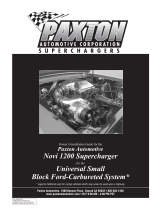Page is loading ...

HOLLEY REPLACEMENT CARBURETOR
GENERAL INSTALLATION INSTRUCTIONS
To preserve warranty, these instructions must be read and followed thoroughly and completely both before
and during installation. Holley Replacement Parts Division cannot and will not be responsible for any
alleged engine or other damage, or other conditions resulting from misapplication of the carburetor
described herein.
WARNING! This carburetor is NOT desiqned for use with ANY automatic overdrive transmissions. If
used on an automatic overdrive vehicle, SEVERE transmission damage WILL result.
Prior to and after installing your replacement carburetor, manually operate the throttle lever and choke
mechanism. Check for any throttle binding or other malfunction. Also, make a visual inspection of the
carburetor, looking for bent levers, missing parts or any possible shipping damage. Because this replacement
carburetor is designed to fit a variety of applications, It may provide more vacuum fitting tubes and/or hoses
than the original carburetor. Some provided small parts might not be needed in various applications.
REMOVAL:
Before disconnecting the various hoses, linkages, and springs from original carburetor, it's advisable to tag each in
some manner, so as to avoid confusion during installation of your replacement carburetor. Be sure to trace each
line from original carburetor to its component, such as the distributor, then label that line. In the event that any
components are strange or unknown, use a numbering system that corresponds each line to its component.
1. Label and disconnect all vacuum hoses and electrical lines from the original carburetor. Disconnect the fuel
line and retain the clamp.
WARNING! Carefully protect the open end of the fuel line, so that no foreign particles can enter. Wrap the
end of the fuel line with a clean lint-free cloth.
2. Remove the carburetor hold down nuts. Loosen and remove the old carburetor. Place it over a suitable
container and turn it upside down, in order to drain all the remaining gasoline from the fuel bowl. WIPE UP
ANY SPILLED FUEL TO MINIMIZE A FIRE HAZARD.
3. Clean the gasket surface thoroughly. Place a clean cloth over manifold opening to prevent any foreign
materials from entering engine. Protect all exposed ends of lines and hoses from dirt contamination.
CAUTION: Dirt entering the engine will impair vehicle performance and can cause expensive engine
damage.
INSTALLATION:
1. Place the new carburetor next to original carburetor. Transfer any solenoids or dashpots from the original
carburetor to new carburetor (if applicable).
2. Place your new carburetor and gasket on the manifold and tighten down the hold down nuts.
CAUTION: Overtightening the carburetor hold down nuts can result in a warped or cracked carburetor
throttle body. The hold down nuts should be tiqhtened down progressively in a criss-cross
pattern, first by hand, and then with the proper wrench. This procedure will prevent vacuum
leaks, while avoiding damage to the carburetor.

WARNING! Fuel system components (including fuel lines and carburetor), should be inspected
periodically to ensure that no future fuel leakage will occur, and to make certain that all
vacuum hoses are sound.
3. Hoses that exhibit surface cracks when bent to a 180° position should be replaced. The presence of liquid fuel
demands re-tightening of loose fittings, and hose replacement as needed.
4. Excluding the fuel line, reconnect the vacuum hoses and electric lines as assembled previously to the original
carburetor. All tubes and vacuum sources not utilized must be plugged in order to prevent vacuum leaks and
unfiltered air from entering tine engine.
WARNING! At this time, with the engine off and fuel lines disconnected, check the throttle operation. Be
certain that there is no interference when the throttle lever is operated between idle and full
wide-open throttle positions. Any binding or interference could cause the throttle to stick open
later during normal vehicle operation and possibly result in an accident due to the loss of
carburetor throttle control (or uncontrolled engine speed).
5. Reconnect the throttle linkage.
6. Connect the fuel line. As a further precaution to any carburetor flooding, the installation of an inline fuel filter is
recommended.
7. Set the parking brake. Block the drive wheels to avoid any vehicle movement. Start the engine and check for
fuel or vacuum leaks.
STARTING INSTRUCTIONS: Rough Idle and Vacuum Leaks
If rough idle exists after the engine has been fully warmed up, check for vacuum leaks. Vacuum leaks can result
from unplugged vacuum fittings, torn or improperly installed flange gasket, improper torque on the carburetor
throttle body to manifold hold down nuts, or through improper reconnection of the vacuum lines. ALL
CARBURETOR TUBES AND HOSES MUST BE PROPERLY RECONNECTED AND/OR PLUGGED IN ORDER
TO MEET EMISSION REQUIREMENTS, AND PROVIDE RELIABLE VEHICLE PERFORMANCE.
SETTINGS AND ADJUSTMENTS:
Refer to the manufacturer's decal in the engine compartment for specific idle speed settings for your vehicle. On
automatic transmission equipped cars, the speed is set WITH THE PARKING BRAKE ENGAGED, THE DRIVE
WHEELS BLOCKED, AND THE TRANSMISSION IN "DRIVE'. On manual transmissions, place the vehicle in
"neutral", WITH THE PARKING BRAKE ENGAGED.
GENERAL:
In addition to your Holley replacement carburetor, attention must be directed to the correct engine timing, spark
plug gap and heat range, sound primary and secondary wiring and operational PCV, EGR, and heat riser systems.
These separate, but important factors, each effect the economy and performance of your vehicle's engine. An
automotive system cannot perform to its maximum potential without proper
maintenance and adjustment of all its
components.
Holley Performance Products
1801 Russellville Road
Bowling Green, KY 42101-3542
Phone: (270) 781-9741
Toll-Free Phone: (866) GOHOLLEY
For online help, please refer to the Tech Service section of our website: www.holley.com

199R-9527
Date: 2-2-04
/


